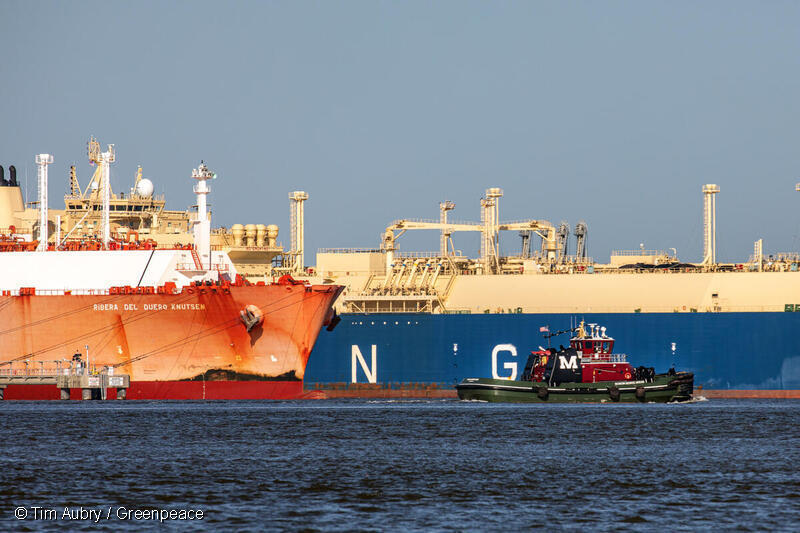Media Briefing: U.S. Liquefied Gas Flooding Europe
EUROPE, 1 May 2023
Tim Donaghy | Greenpeace – TRANSCEND Media Service
27 Apr 2023 – The oil and gas industry has moved quickly to take advantage of the disruptions caused by Russia’s invasion of Ukraine. In 2022, a surge of shipments of liquefied natural gas (LNG) from the United States was redirected to Europe in order to replace Russian pipeline gas and secure supplies for the European winter. By taking advantage of this short-term energy crisis, the industry has also secured financing and begun construction on numerous LNG terminals on both sides of the Atlantic that are designed to operate for decades to come.
Key Findings:
- If Europe enacts ambitious climate change policies to phase out fossil gas use by 2035, then Europe will be able to halt all imports of liquefied natural gas (LNG) prior to 2030.
- Policies to phase down gas consumption in Europe would remove the need for new LNG export terminals in the United States, which would in turn help phase out harmful oil and gas drilling across the U.S. – from Texas to Pennsylvania.
- Such policies would help put both the U.S. and Europe on a pathway to limit global warming to 1.5°C (2.7°F) and meet the goals of the Paris Agreement.
- However, the oil and gas industry is seizing a moment of crisis to drive a massive build out of LNG infrastructure on both sides of the Atlantic that will lock us into reliance on fossil gas and put our climate goals out of reach.
- This build out is anchored by long-term contracts to export U.S. LNG to Europe for decades to come. In 2022 alone, 17.65 million tonnes per annum (mtpa) of new LNG (equivalent to 848 billion cubic feet of gas, bcf) was contracted for sales to European gas companies. These contracts would continue for 15 to 20 years.
- In Europe, eight LNG import terminals are under construction and 38 more have been proposed. If built, these could more than double Europe’s LNG import capacity to 38 billion cubic feet per day (bcf/d) and result in an additional 950 million tons of CO2-eq emissions per year.
- In the U.S., there are seven operating export terminals, three terminals under construction, twelve new and expanded terminals that are approved but awaiting financing, and numerous proposed projects that have not yet been approved. If built, the approved projects alone could more than double U.S. export capacity to 42 bcf/d – with annual lifecycle emissions equivalent to 393 million cars.
- By 2030, U.S. LNG export by itself could be larger than the Net Zero Emissions (NZE) estimate by the IEA for global LNG trade.
- This LNG expansion threatens the health of communities living near these export terminals, and also those living near extraction sites and pipelines, which could see impacts from increased production. LNG contributes to fossil fuel racism, whereby Black, Brown, Indigenous, and poor communities are disproportionately harmed by pollution and climate impacts.
- While the energy crisis has led to record profits for oil and gas companies, families in the U.S. and Europe have struggled to make ends meet, and Global South nations suffered from high energy prices.
- Policy makers in both Europe and the U.S. have the ability to halt this LNG buildout, break the carbon lock-in inherent to long-term LNG contracts, and put both regions on a pathway to a green and just future.
Read the U.S. Media Briefing
Read the full Greenpeace International report, Who Profits From War: How Gas Corporations Capitalise on War in Ukraine
Download: Media-Briefing-LNG-report.pdf
_______________________________________________
 Tim Donaghy is a Senior Research Specialist with Greenpeace USA. He writes frequently about climate change, offshore oil drilling, energy production, and the Arctic.
Tim Donaghy is a Senior Research Specialist with Greenpeace USA. He writes frequently about climate change, offshore oil drilling, energy production, and the Arctic.
Go to Original – greenpeace.org
Tags: Corruption, Denmark, Eastern Europe, Energy, European Union, Gas, Hegemony, Imperialism, Military Industrial Media Complex, Multipolar World Order, NATO, Nordstream 2, Norway, Nuclear war, Pentagon, Proxy War, Putin, Russia, Seymour Hersh, State Terrorism, US Military, US empire, USA, Ukraine, War Economy, Warfare, West
DISCLAIMER: The statements, views and opinions expressed in pieces republished here are solely those of the authors and do not necessarily represent those of TMS. In accordance with title 17 U.S.C. section 107, this material is distributed without profit to those who have expressed a prior interest in receiving the included information for research and educational purposes. TMS has no affiliation whatsoever with the originator of this article nor is TMS endorsed or sponsored by the originator. “GO TO ORIGINAL” links are provided as a convenience to our readers and allow for verification of authenticity. However, as originating pages are often updated by their originating host sites, the versions posted may not match the versions our readers view when clicking the “GO TO ORIGINAL” links. This site contains copyrighted material the use of which has not always been specifically authorized by the copyright owner. We are making such material available in our efforts to advance understanding of environmental, political, human rights, economic, democracy, scientific, and social justice issues, etc. We believe this constitutes a ‘fair use’ of any such copyrighted material as provided for in section 107 of the US Copyright Law. In accordance with Title 17 U.S.C. Section 107, the material on this site is distributed without profit to those who have expressed a prior interest in receiving the included information for research and educational purposes. For more information go to: http://www.law.cornell.edu/uscode/17/107.shtml. If you wish to use copyrighted material from this site for purposes of your own that go beyond ‘fair use’, you must obtain permission from the copyright owner.

